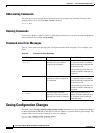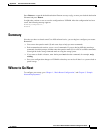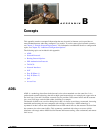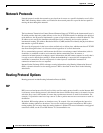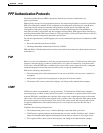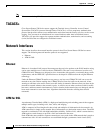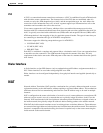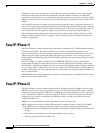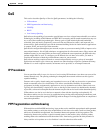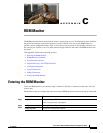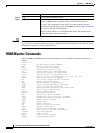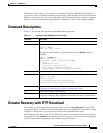
B-6
Cisco Secure Router 520 Series Software Configuration Guide
OL-14210-01
Appendix B Concepts
Easy IP (Phase 1)
Translations can be static or dynamic. A static address translation establishes a one-to-one mapping
between the inside network and the outside domain. Dynamic address translations are defined by
describing the local addresses to be translated and the pool of addresses from which to allocate outside
addresses. Allocation occurs in numeric order, and multiple pools of contiguous address blocks can be
defined.
NAT eliminates the need to readdress all hosts that require external access, saving time and money. It
also conserves addresses through application port-level multiplexing. With NAT, internal hosts can share
a single registered IP address for all external communications. In this type of configuration, relatively
few external addresses are required to support many internal hosts, thus conserving IP addresses.
Because the addressing scheme on the inside network may conflict with registered addresses already
assigned within the Internet, NAT can support a separate address pool for overlapping networks and
translate as appropriate.
Easy IP (Phase 1)
The Easy IP (Phase 1) feature combines Network Address Translation (NAT) and PPP/Internet Protocol
Control Protocol (IPCP). This feature enables a Cisco router to automatically negotiate its own
registered WAN interface IP address from a central server and to enable all remote hosts to access the
Internet using this single registered IP address. Because Easy IP (Phase 1) uses existing port-level
multiplexed NAT functionality within Cisco IOS software, IP addresses on the remote LAN are invisible
to the Internet.
The Easy IP (Phase 1) feature combines NAT and PPP/IPCP. With NAT, the router translates the
nonregistered IP addresses used by the LAN devices into the globally unique IP address used by the
dialer interface. The ability of multiple LAN devices to use the same globally unique IP address is known
as overloading. NAT is configured on the router at the border of an inside network (a network that uses
nonregistered IP addresses) and an outside network (a network that uses a globally unique IP address; in
this case, the Internet).
With PPP/IPCP, Cisco routers automatically negotiate a globally unique (registered) IP address for the
dialer interface from the ISP router.
Easy IP (Phase 2)
The Easy IP (Phase 2) feature combines Dynamic Host Configuration Protocol (DHCP) server and relay.
DHCP is a client-server protocol that enables devices on an IP network (the DHCP clients) to request
configuration information from a DHCP server. DHCP allocates network addresses from a central pool
on an as-needed basis. DHCP is useful for assigning IP addresses to hosts connected to the network
temporarily or for sharing a limited pool of IP addresses among a group of hosts that do not need
permanent IP addresses.
DHCP frees you from having to assign an IP address to each client manually.
DHCP configures the router to forward UDP broadcasts, including IP address requests, from DHCP
clients. DHCP allows for increased automation and fewer network administration problems by:
• Eliminating the need for the manual configuration of individual computers, printers, and shared file
systems
• Preventing the simultaneous use of the same IP address by two clients
• Allowing configuration from a central site



